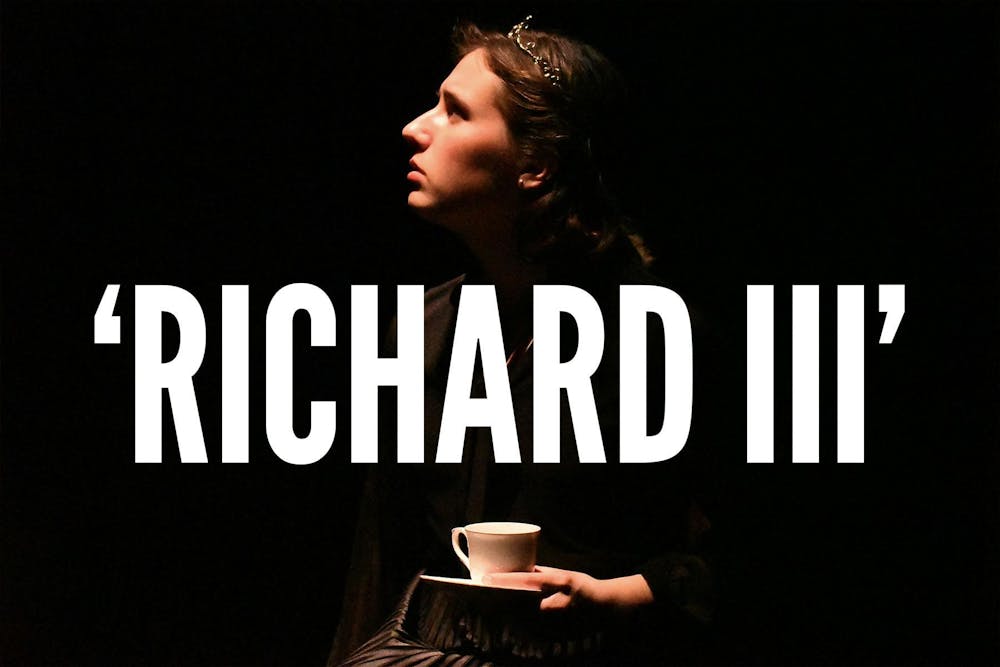So far this year, Notre Dame’s Not-So-Royal Shakespeare Co. has produced “Love’s Labor’s Lost” (essentially a 1598 romcom) as well as “Rodeo and Juliet” (a spaghetti western reimagining of the original play). They do this sort of thing — light comedy and melodrama — really well. So when they announced their intention to perform “Richard III,” I was intrigued. “Richard III” is rife with death and shooting and strangling and poisoning and stabbing and more. Its kill-count? At least 12. I was eager, and nervous, to see how they would handle it.
(Editor's Note: Peter Mikulski is not associated with the Not-So-Royal Shakespeare Co., but several Scene copyeditors are.)
Their production is violence-forward; that’s a surprise, coming from the people who inserted “Rasputin” by Boney M. into “Love’s Labor’s Lost” and a square dance into “Rodeo and Juliet.” Director Josh Lehman explicitly stages what are, in the text, implied deaths. I’m curious to what extent this was an artistic decision or a practical one meant to keep the action going and the plot clear in a production that fits roughly 4,000 lines into about two hours.

Still, the Not-So-Royal brings the comedy. Rivers and Grey (Andrew Arcidiacono and Anna Falk) are played as two velvet-vested, cocktail-drinking, cigarette-smoking, cocaine-snorting dandies. The princes in the tower (Sam Capodicci and Madison Denchfield) are played as two little caricatures of Edwardian boys in very short khakis and very long ties. I wouldn’t call these characters “comic relief,” though. Instead of making the play less tragic, they actually make it infinitely more tragic. When an evil character dies, good riddance! But when a funny character you like is brutally murdered on stage? That’s disturbing — really disturbing. This production made me laugh, but it also made me squirm. Some people like that sort of whiplash, and some people don’t: I belong to the first camp. I don’t think Shakespeare intended “Richard III” as a feel-good comedy, and this company gets that.
Dominic Keene aces the titular role, also mixing tragedy and comedy. He’s the sort of villain who charms you whether you like it or not, adding to the unsettling air of the production. Likewise, Brittany Alvarez is a great Margaret — deranged in a way that’s both depressing and endearing. Hannah Smith as Catesby is similarly compelling, playing with the dissonance between her goody-goody delivery and her despicable character. Will Barrett and DJ Adams play several roles, but their best moment is as Murderer 1 and Murderer 2 in a dialogue that blends the witty and the soul-crushing.

Tommy Liddy is a solid Clarence, who grounds the play’s first half (which is relatively light) with a serious performance. Ryan Palmer plays Stanley with solid craftsmanship and good technique too. The costumes and sets are very effective — also very nice to look at — and they never get in the way.
This show rarely falters, but when it does, it gets dour. When the actors were “serious," when they did the A24 protagonist voice, they stumbled under the weight of the piece — but when actors leaned into the production’s tragicomedy, they thrived.
While I was worried the Not-So-Royal Shakespeare Co.’s twee proclivities and comedy chops would ruin “Richard III,” that’s ultimately what made the play a hit.
(P.S. What ever happened to the proscenium arch? Whatever happened to a theater where the actors work on the stage and the audience sits in the house? It’s always a thrust stage or theatre-in-the-round these days. I understand that, more often than not, it’s the venue that picks the company rather than the company that picks the venue — that you take what you can get. And the Not-So-Royal Shakespeare Co. uses its thrust stage well. Today, however, the most radical decision a theater production at Notre Dame could make would be to keep the actors on the stage, and not indulge in audience interaction. Trust that the audience will watch the show — even without actors dancing at us from the aisle!)










